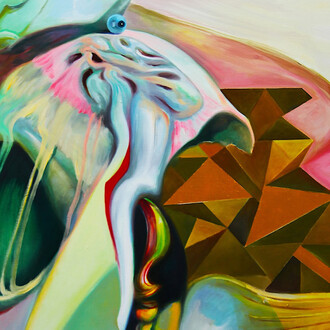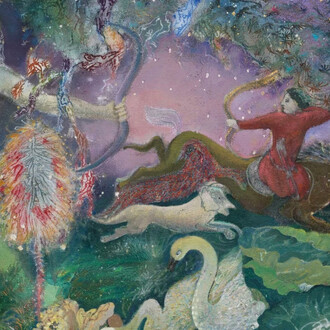Fancy hair. White face. A nipple. Cindy Sherman’s (1954) Untitled #225 shows how much of an eye-catcher a simple exposed breast can still be. It figures in the Victoria and Albert Museum’s exhibition Botticelli Reimagined, even if it more so resembles the work of another artist, namely Bartolomeo Veneto’s (c. 1470-1531) Idealised Portrait of a Courtesan as Flora (c. 1552; see below). A nipple of the ideal beauty… Renaissance, overcoming medieval prudery, made it possible. It was none other than Sandro Botticelli (c. 1445-1510) who created the icon of the return to ancient paganism and its fun-loving, therefore preferably nude gods in his Birth of Venus. He ingeniously introduced eroticism to a devout Christian world. Anyone mind a closer look?
The attractiveness of Botticelli’s Venuses (yes, there are more than one!) is generally acknowledged. Even James Bond fell for one of their descendants. But we must not forget that since late antiquity, the predominant Christianity had been preaching chastity and celibacy. The art of the nude had declined alongside with the ancient gods. Beginning with Dante Alighieri (1265-1321) and Francesco Petrarca (1304-1374), they made their way back into art and literature. They were reborn. Two centuries later, Lorenzo the Magnificent (1449-1492), Botticelli’s Medici patron, summed up the new way of life:
Youth is sweet and well
But doth speed away!
Let who will be gay,
To-morrow, none can tell.
This had to be kind of a challenge for an artist like Botticelli, a rather pious Christian, who had mostly been painting Madonnas, little Jesuses, and portraits until then. How could he fit the proclaimed hedonism in his paintings? The solution he found was brilliant.
His two most famous paintings, the inevitable Birth of Venus (1482-1485) and Primavera or Allegory of Spring (c. 1482), both depict pagan motifs. Their erotic implications are not limited to the undeniable sex appeal of the main characters (their poses reminding those of present-day starlets on the red carpet). As we said, naked women were far from being an unusual motif. In order to understand their sensual dimension, we should have a quick look at a painting from the most prude era one could possibly imagine: England’s Victorian age.
In 1877, Walter Crane (1845-1915) painted The Renaissance of Venus. The title clearly relates it to Botticelli’s masterpiece. At first glance, one might take Crane’s version for the more erotic painting: Whereas the original Venus chastely covers herself, her reborn alter ego does not hide a thing from us. But the three female nudes in the background of the English canvas tell a different story. They stare longingly at the ancient goddess. Beautiful as she may be, she cannot, she must not be approached. One thing is for sure: no intercourse here. The Victorian era was indeed Victorian. In contrast, the Italian master created a highly approachable Venus. All movements go towards her.
The same cannot quite be said about his Primavera or Allegory of Spring. In fact, movements seem to be unrelated altogether here. Again, Venus occupies the centre. Or is it Venus? The myrtle tree behind her, sacred to the Roman goddess of love and beauty, seems to point towards this interpretation. But if it wasn’t for the pagan setting – including, from left to right, Mercury, the Three Graces, Cupid, Flora, Chloris and Zephyrus – couldn’t it just as well be the Virgin Mary, so often depicted by Botticelli? And if so, wouldn’t that be a sacrilege?
It would, if we were not talking about Renaissance art. Botticelli’s biggest achievement was to bring together paganism and Christianity, to combine erotic Venus and devotional Mary. This provides us a guideline for the interpretation of Primavera or Allegory of Spring.
Neoplatonism, unsurprisingly highly en vogue in the Renaissance, knew two kinds of love, terrestrial and divine: the one between mortals and the one between man and God. These are represented on the canvas as the main figure splits it into the two realms of love.
Legend has it that Zephyrus, god of the west wind, abducted the nymph Chloris in order to first rape then marry her. Thus the couple on the right-hand side represents lust and terrestrial love. Opposite of them, the Three Graces dancing in a circle allegorise the perfect and chaste union of man and God, that is divine love, guided by the keeper of boundaries, Mercury. Last but not least, Flora, headed from right to left, leads the way to the higher sphere.
As we see, Venus and Mary, sexuality and spirituality, are rightfully incarnated in one figure. They are the two faces of human love, the two souls housed within a Renaissance breast – be it exposed or not.
Text by Arik Jahn
Sources:
Émile Gebhart/Victoria Charles: Sandro Botticelli, New York: Parkstone International, 2010
www.academia.edu
www.metmuseum.org















